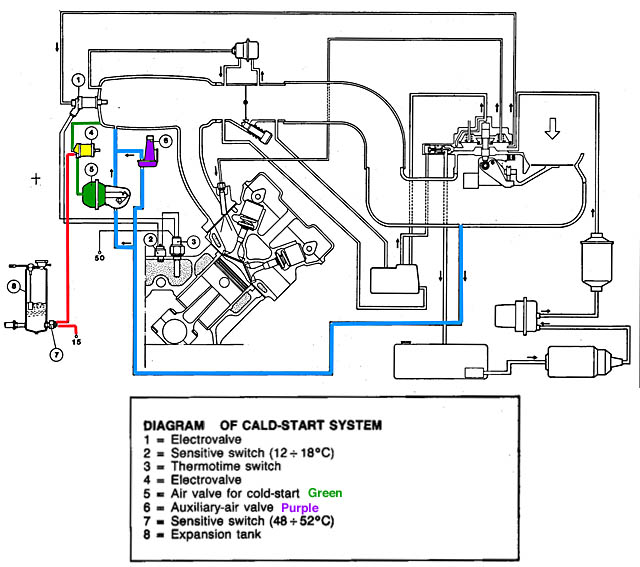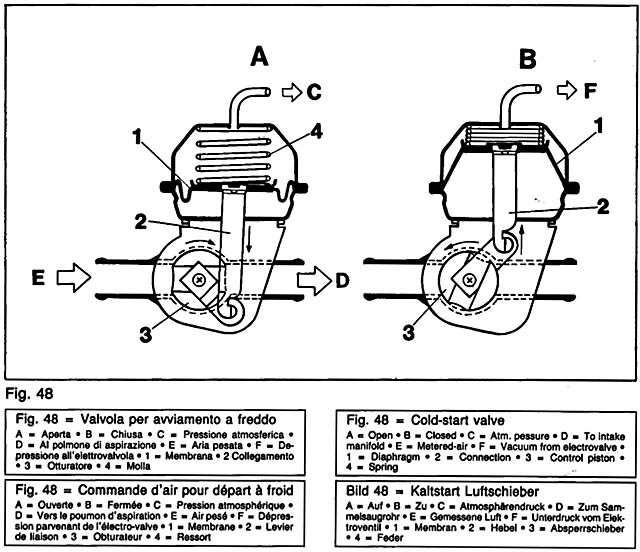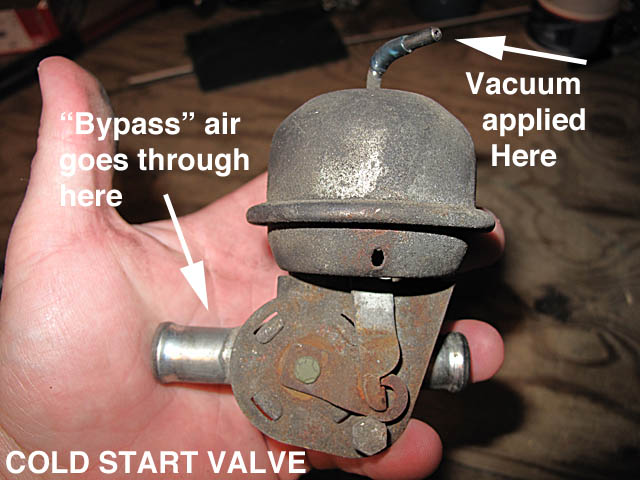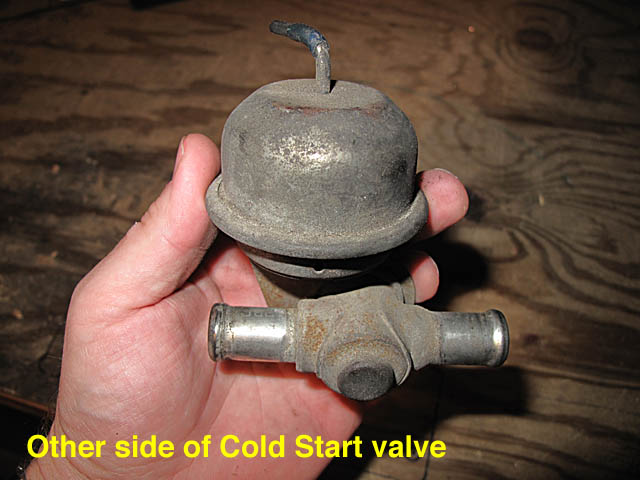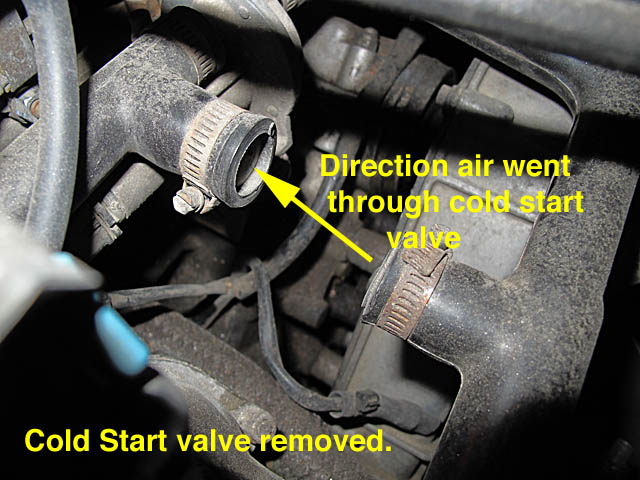
|
The Mondial and 308 (Injected) Cold Start Mechanism (USA Cars Only, non-lambda K-jet only, model years 1980-83) In their infinite wisdom, the U.S. emissions control people back in the day decided that the world would be a better place if the catalytic converters on Ferraris warmed up faster, so they would produce less emissions. You see, until a catalytic converter is hot, it doesn't do much of anything. So the clever engineers at Ferrari, certainly against their will, had to come up with a way to rev the engine when it was cold to get those cats hot fast. The result was the "Cold Start" (super high idle) system that all the USA-spec injected 308s and Mondials got. This thing sucks. When functioning properly, its goal is to wear out your engine as quickly as possible. It does this by advancing the idle to about 2500 RPM at startup on a cold engine. It pretty much goes against everything we know about cold engines--don't rev them until they are warmed up a little! I removed the system from my Mondial entirely. Other people opt to simply disable it. Please do not worry--no other markets in the world got Ferraris with this stupid system in them. You are doing your Ferrari a favor to remove/disable it. Before I explain how, let me explain how it works. See figure 1, a diagram of the cold-start system from the Mondial service manual:
You will notice that there is a blue line running from the fuel distributor housing on the right over to a purple device on the left. The purple device is called the Auxiliary Air valve. This valve allows a tiny bit of air through it when the engine is cold to help the engine idle better. All cars with Bosch K-jet have this gadget. But in the USA-market cars, there is an additional device, which I have colored green above, called the Cold-start Valve. This valve does exactly the same thing as the Aux Air valve as you can see in the diagram above: it sends some air into the plenum when it's open, and doesn't send air through when closed. So why have two different devices doing the same exact thing? Because each is operated by separate systems, and the Cold-start valve is a band-aid thrown onto the USA-market cars on top of the system that all the cars got. So how does it work? Well, when the coolant is below about 50 degrees C (about 120 degrees F) the switch in the bottom of the coolant tank (marked 7 in the diagram above) is open, so there is no current through the electrovalve (in yellow, #4 on diagram). Without power, the electrovalve is closed. The electrovalve is an air valve that can allow vacuum (in green) from the plenum to the Cold-start valve. So when the electrovalve is closed, no vacuum gets to the Cold-start valve, and that valve is open, allowing air through. Once the engine warms up enough that the coolant reaches a temperature higher than 50 degrees C, the switch in the coolant tank will close. Now there is current through the electrovalve and it opens. This allows vacuum from the plenum to reach the Cold-start valve, which closes it. There is one point of confusion here, which is that different years and models may have a slightly different switch/electrovalve logic. Although my car worked as outlined above, certain electrical schematics/service manuals show that the cold coolant tank has a closed switch, which also lights a warning light on the dash showing that the engine is cold. It would be coupled with an electrovalve that also has opposite polarity (electrovalve is closed when it has applied power). So you may have to check and see which way yours works if you use method #2 below. To find out, just use a multi-tester to check and see if the switch on the bottom of the coolant expansion tank is open or closed when cold. If open, it works as described above. If it's closed when cold, it works the other way. I would be interested to hear from people who have ones closed when cold to compare notes. OK, back to the discussion.... Anything seem weird here? Look at the diagram of the Cold-start valve:
The Cold-start valve has three hose ports on it. Two big ones, labeled E and D above. That's where the bypassed air goes in and out. It also has a vacuum port, which is the small one on top. When vacuum is applied, it sucks the diaphragm against the spring pressure and closes the valve between E and D. He's the strange part. It defaults to an open position if no vacuum is applied to the vacuum port! That means that if there is some problem with one of your vacuum lines and you have no vacuum to this valve, the valve will never shut and the idle will never come down! BAD! BEST WAYS TO DISABLE Some people want to keep the Cold-start valve in there to make the engine look "right" (even though only the USA cars had this). In that case there are two ways to do it. They both involve making sure that there is a vacuum applied to the top of the Cold-start valve at all times, even during cold start, to keep it closed tightly: 1. Take the vacuum line from the top of the Cold-start valve and hook it directly to the vacuum port on the plenum that normally goes to the electrovalve. This bypasses the electrovalve and the switch on the expansion tank completely from the circuit. Unless the Cold-start valve fails, this will very effectively remove the cold-start revving. Note, if you completely remove the cold start valve, you may need to adjust the baseline idle speed with the bypass adjuster on the throttle body, because there is often a small amount of leakage through the cold start valve even when "closed." If you completely remove the cold start valve, you no longer have this leakage, and the idle speed could drop a little, so you might need to compensate a little by tweaking the idle speed a little at the throttle body. 2. Next last (worst) option is to use the electrical system to force the electrovalve to stay open, which keeps the vacuum applied to the cold start valve at all times. I say this is the worst option because more things can fail, causing the cold start valve to open. If your system has a coolant expansion switch that is open when cold, you need to pull both wires off the switch and connect them together with a "jumper" so that the electrovalve has power. That forces it to stay open and deliver vacuum to the cold start valve. Basically you are forcing the equivalent of the "warm" operation of the electrical circuit. If your coolant expansion switch is of the variety that is closed when cold, then simply pull one of the electrical connectors off the switch on the bottom of the coolant expansion tank. This means there will never be current though the electrovalve and it will stay open. Again you are forcing the equivalent of the "warm" operation of the electrical circuit. But if the electrovalve is defective or leaks, or any of the vacuum lines leak, the Cold-start valve will not get vacuum and will open. Because the Cold-start valve is normally open and requires vacuum to close, the more things in the path of the vacuum line, the more potential issues. The cold-start valve concept is bad for the engine and was only added for U.S. emissions compliance. It will not harm your engine to disable it as no other Ferraris of this era had this modification in any other world markets. And your car will still start just fine in cold weather. Ironically, the real "cold start" valve is the Auxiliary Air valve, which is not affected by this modification. But of course, please do not take the above as advice for the modification of a U.S. emissions system. This is for informational purposes only! :-) Additional pics:
|
